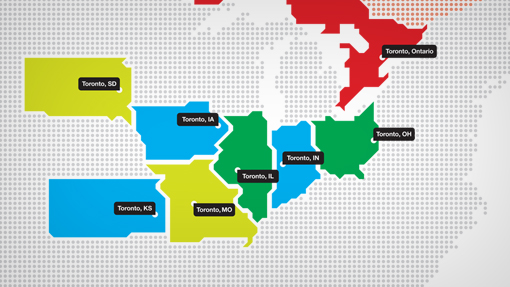Why did Watson think Toronto was in the U.S.A.?
How that happened tells us a lot about what AI can and can’t do, to this dayIn a recent Mind Matters podcast, Bradley Center director Robert J. Marks and economics prof Gary Smith discussed IBM Watson’s curious 2011 Jeopardy flub. In the midst of a triumph against two international Jeopardy stars, it confused Chicago with Toronto. How that happened tells us a lot about what AI can and can’t do, to this day.
At the time, many found the goof shocking:
For those of you watching the Jeopardy! IBM Challenge, you’re probably shocked that Watson, who cleaned the board last game, missed the “Final Jeopardy!” question. Not only did he completely guess wrong, he had an answer so off the mark it shocked the audience (and the neighbor’s north of the U.S.) In response to “Its largest airport is named for a World War II hero; its second largest, for a World War II battle” in the category of “U.S. Cities,” Watson said “What is Toronto?”
Michelle Castillo, “Why Did Watson Think Toronto Is A U.S. City on ‘Jeopardy!’?” at Time
While Toronto is less well-known than many smaller American cities, a competent Jeopardy player might have been expected to know that it is Canada’s largest city (7th largest in North America).

Rushing to Watson’s defense, IBM stopped just short of saying “Watson is right!”:
No, Watson isn’t prejudiced against Canadians. According to IBM principle investigator on the Watson project David Ferrucci, the machine probably didn’t realize that the city had to be in America. After all, even though we know that U.S. and America typically mean the same thing, it doesn’t literally mean the same country. (For example, any number of Central and South American countries can be considered an “American” country.) Furthermore, there’s a Toronto in Illinois—although it’s too small to have an airport—and Toronto in Canada has an American League baseball team.
Michelle Castillo, “Why Did Watson Think Toronto Is A U.S. City on ‘Jeopardy!’?” at Time
This is all very interesting but none of it places O’Hare airport in Toronto or Toronto in the United States.
A tech writer who wrote a book on the contest provides an insider’s look at the challenges:
As I write in Final Jeopardy, the team building the machine actually had a group—the so-called “dumb team”—to try to steer Watson away from embarrassing gaffes. These were most likely to occur in Final Jeopardy, where the clues are more complex and Watson is compelled to respond, even if it has low confidence, as it did in Toronto. The team even considered programming to the computer to throw up its hands when puzzled, and just say it didn’t know. But instead, they let it guess… If this had been a normal Jeopardy clue, Watson would not have buzzed. It had only 14% confidence in Toronto (whose Pearson airport is named for a man who was active in World War One), and 11% in Chicago. Watson simply did not come up with the answer, and Toronto was its guess. (It communicated its low confidence by adding a lot of question marks. …
Stephen Baker, “How Could IBM’s Watson Think That Toronto Is a U.S. City?” at HuffPost (May 25, 2011)
Strictly speaking, the answer Watson spit out was “What is Toronto?????”, which does sound distinctly less than certain.
Media at the time got some of the take-home points right:
Watson uses more than 100 different algorithms, each one looking at a Jeopardy! clue, to determine the likely answer. But it doesn’t actually “know” anything, in the traditional sense.
CTV.ca News Staff, “IBM’s computer wins ‘Jeopardy!’ but… Toronto?” at CTV (February 15, 2011)
Eric Nyberg, who has worked on Watson with its IBM creators since 2007… A human would have considered Toronto and discarded it because it is a Canadian city, not a U.S. one, but that’s not the type of comparative knowledge Watson has, Nyberg said.
“A human working with Watson can get a better answer,” said James Hendler, a professor of computer and cognitive science at Rensselaer Polytechnic Institute. “Using what humans are good at and what Watson is good at, together we can build systems that solve problems that neither of us can solve alone.”
Associated Press, “IBM’s Watson trounces humans at Jeopardy” at CBC
To this day, on a page dedicated to explaining the error, IBM offers a map showing the many towns, villages, and hamlets in the United States that are named Toronto, none of which has a major international airport named after anyone.
Incidentally, Stephen Baker’s information, “Toronto (whose Pearson airport is named for a man who was active in World War One)”, inadvertently highlights another problem. Toronto’s Lester B. Pearson airport was indeed named in 1984 after Canada’s 14th Prime Minister (1963–68). Pearson also received the Nobel Peace Prize in 1957 for heading off the Suez Canal crisis.
And he did serve in World War I: “His military career came to a sudden end when he was run over by a London bus and invalided home.” That phase of his life is hardly the one for which he is commemorated in the airport’s name. Which suggests that assessment of relevance may not be the greatest strength of a Watson type program. (See Lester B. Pearson (1897–1972), The Canadian Encyclopedia)
Here’s the podcast with Gary Smith:
Here are the Show Notes.
Gary Smith is the author of The AI Delusion.
See also: Why an AI pioneer thinks Watson is a fraud. The famous Jeopardy contest in 2011 worked around the fact that Watson could not grasp the meaning of anything. Gary N. Smith explains that a computer’s inability to understand what “it” means in a sentence is because it doesn’t understand what any of the words in the sentence mean.
Featured image: Toronto skyline/carlos, Adobe Stock
